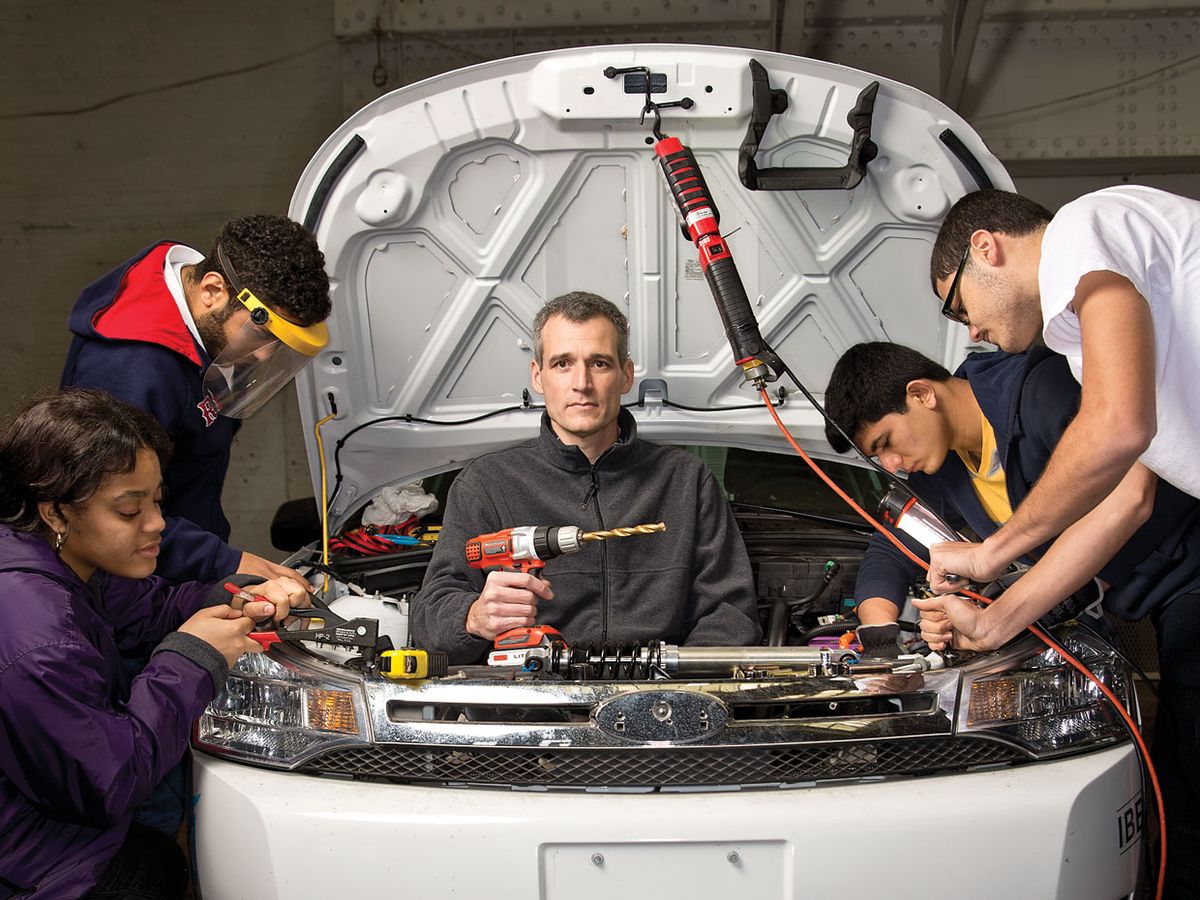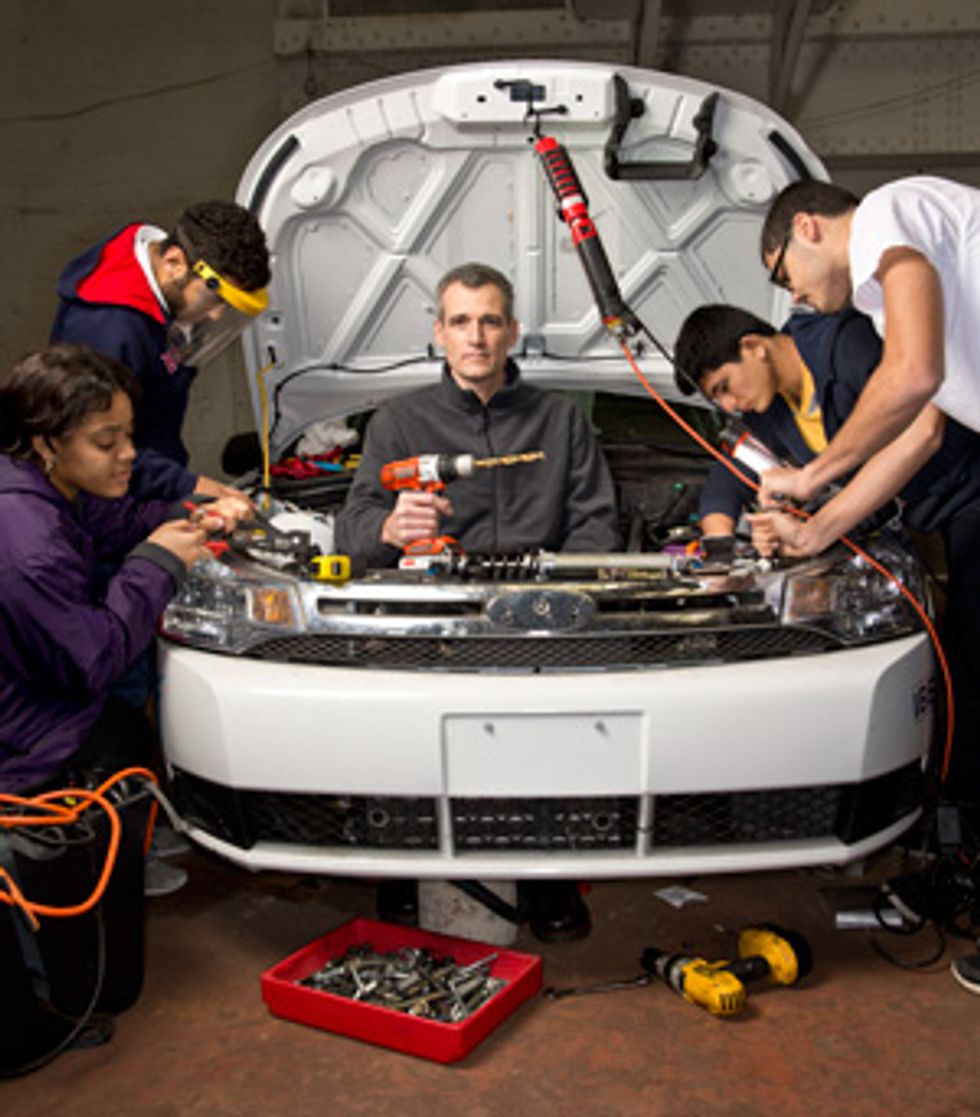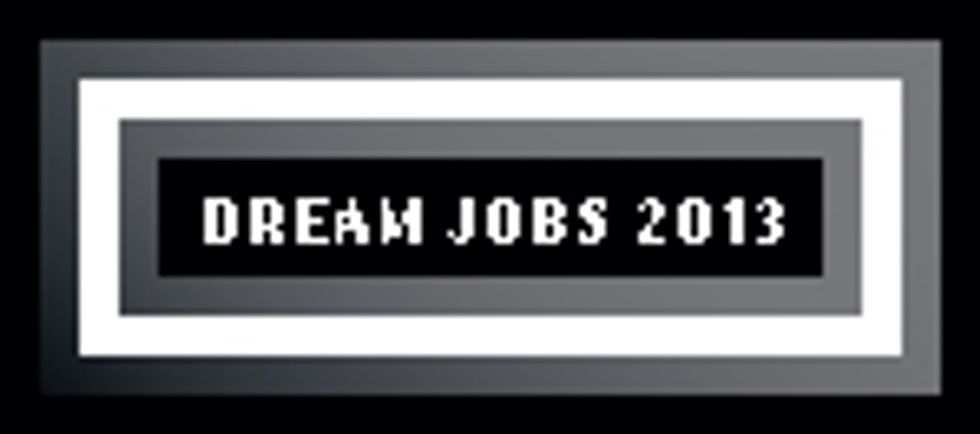Simon Hauger Revs Up High Schools with Car Projects
Simon Hauger helps inner-city high schoolers build cars and start businesses


The dark gray Jeep Wrangler, modified to run off batteries instead of gasoline, wowed the judges at the Pennsylvania state science fair. The year was 1999, and electric vehicles of any kind were still a novelty in the United States. But then the judges took a closer look at the high school students who had converted the Jeep—mostly black teenagers from an inner-city Philadelphia neighborhood—and decided they couldn't possibly have done the work themselves. So the judges passed the e-Jeep by, awarding their highest rankings to lesser projects.
Simon Hauger, an electrical engineer turned math teacher, was mentoring the students, and he protested—loudly—that the judges should at least have questioned his team before drawing conclusions. The event organizers' response? The youngsters needed to learn that sometimes life just isn't fair. But these kids had already received more than their share of hard lessons. “One kid's father was dying of AIDS," says Hauger, the outrage he felt at the time still audible in his voice. “The conversation turned ugly, and they told me to leave because I started to lose it."
To avoid any further such incidents, Hauger steered his students away from science fairs and toward a more objective competition: the American Tour de Sol, an annual road rally for solar, electric, hybrid, and alternative-fuel vehicles. In their third year of competing, Hauger's students achieved first place in the all-electric category and second in hybrids, beating many college teams. They went on to take the tour's top honors with a head-turning hybrid-electric sports car in 2005 and also in 2006, the competition's final year.In 2007, Hauger got wind of a new and even bigger event, the US $10 million Automotive X Prize. Intended to spur the commercialization of superefficient vehicles, this global competition was aimed at industry, requiring entrants to submit business plans and to design production-ready prototypes. So Hauger explained to his students that the X Prize wasn't for them. “Like most people, when you're told you can't do something, you really want to do it more," he says. At his students' urging, Hauger registered his team for the competition—the only high school group to do so.
Soon, the West Philly X Prize team began to garner attention in local and even national press, and the school's automotive shop started getting some famous visitors: a Pennsylvania congressman, a NASA rocket scientist, even rapper Wyclef Jean, who is “an off-the-charts car buff," according to Hauger. “I keep waiting to wake up from this X Prize Dream I seem to be trapped in," he wrote at the time on his blog.
But the dream continued. Against all odds, they ended up as one of 30 teams, from a field of 111, to make it to the on-track trials. The West Philly team entered two cars that they had hybridized: a Ford Focus and a kit car called the GTM Supercar, from Factory Five of Wareham, Mass. Neither was quite able to achieve the 67-mile-per-gallon (3.5-liters-per-100-kilometer) fuel efficiency needed to get past the second round of the trials, held in the spring of 2010 at the Michigan International Speedway. But it almost didn't matter. Hauger's students were considered heroes in Philadelphia—and in Washington, D.C.
President Obama invited them to the White House and noted their achievement in a speech introducing an educational initiative: “They didn't have a lot of money; they didn't have the best equipment; they certainly didn't have every advantage in life. What they had was a program that challenged them to solve problems and to work together, to learn and build and create."
Hauger grew up in Philadelphia, where he went on to study electrical engineering at Drexel University. There he entered the co-op program, which combines academic study with employment in local industry. Hauger says he enjoyed the analog-design work he did for General Electric, but after looking at the older engineers in the cubicles around him, he “had an epiphany"—an apt choice of words given that his decision to switch gears and go into teaching was motivated, at least in part, by religious convictions.
After earning a bachelor's degree in electrical engineering in 1993, he immediately enrolled in Drexel's School of Education, where he obtained a master's degree and a teaching certification. He then applied to the Philadelphia school district, although any of the nearby suburban schools would have paid much better. “Growing up in the city, I experienced a lot of the injustices we have in society firsthand—even though I'm not a minority," he says. “So I didn't want to just be a math and science teacher; I wanted to be an urban math and science teacher." So he went to work in West Philly.
He soon realized, though, that the educational system he had become part of was badly broken. “You see kids dropping out, and you know what the consequences are. It is incredibly difficult to make sense of that and continue in the profession," he says.
So 15 years ago, he took matters into his own hands, by helping kids assemble electric and hybrid cars after hours in West Philadelphia High's automotive shop. He wasn't paid for these after-school activities; indeed, he often spent his own money on equipment and supplies. But seeing his students become increasingly engaged with school through this informal program, he knew his investment was paying dividends.
“Teaching doesn't have to look like desks in rows in classrooms," he says. Educators work that way only because “we're forced into the most-efficient delivery system." In underserved urban districts like West Philadelphia, he adds, that system breaks down. “The results are horrific—50 percent of kids are dropping out."
Now Hauger is taking this hands-on approach to a new level—he's building his dream school.
Hauger and a small group of like-minded teachers hope to harness the power of project-based learning in a school they are designing from scratch, called the Sustainability Workshop. They are now fleshing out their ideas in a two-year pilot program that provides an alternative education for 30 Philadelphia-area high school seniors. It's housed in a small Victorian-era building in the city's old naval yard, now a hub of energy-efficiency research and entrepreneurship.
Hauger has brought his own formidable problem-solving skills to bear in this endeavor. “He thinks about how to engineer a school," says Aiden Downey, a cofounder of the Sustainability Workshop and a professor of educational studies at Emory University. “When people say, 'school,' they think, 'Sit down, shut up, start writing, and take a test.' This is so different."
“Problem-based and project-based education is…messier," Hauger admits. “It's not as efficient. There's no way you're going to cover every topic in Algebra II in one year. But where it excels is engagement." He and his colleagues are deliberately incorporating into the curriculum things like communication skills and building students' self-awareness of their personal strengths and weaknesses. “None of that's done in [traditional] high school," he says.
Hauger and his colleagues know they'll need to assess how they're doing as they work to turn the workshop into a full-fledged four-year high school. “Education needs to be held accountable. The question is, to what?" says Hauger. The standardized tests that traditional schools rely on cater to “the lowest common denominator," he says. “Schools all over the country are test-prep machines." The Sustainability Workshop is built on a different premise—that what students will face in life are imperfectly structured problems and that success is best measured with something other than penciled‑in bubbles.
Here's how that premise plays out: To learn how to tackle authentic challenges, workshop students pursue projects that attempt to solve true problems facing society. Last year, for instance, some of them worked to start a business that would provide otherwise-pricey LED bulbs to customers for free; revenues would come from the energy savings that accrue over time. In the process of fleshing out the business plan, Hauger says, one student went from being too shy to address her own classmates to presenting the idea to Philadelphia's mayor, U.S. congressmen, and Google executives. That, says Hauger, was a far larger achievement than getting all the answers right on a multiple-choice exam.
“If standardized testing was guaranteeing future success, we'd all throw our hats into that ring. But it's not," says Hauger. “We'd better come up with a better solution." The Sustainability Workshop provides one promising model. And even if it doesn't prove the best one, thoughtful teachers need to acknowledge the failings of the current paradigm and explore inspired alternatives, he says. “Let's do it and stop making excuses."
This article originally appeared in print as "Hands-On Teacher."
